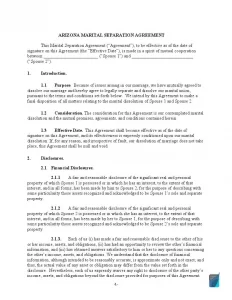Arizona Marital Settlement (Divorce) Agreement and Legal Separation
In real life, not all of our choices prove to be right. Unfortunately, you may find out that you chose the wrong partner after years of marriage. Whether you want it or not, marriage failure will entail some serious legal consequences.
In any state, including Arizona, you will have to go through a tiresome divorce procedure accompanied by a lot of paperwork and, in some cases, long formal court trials. One important form that can save local couples’ time in court is a Marital Settlement Agreement (also known as a Separation Agreement).
Only the spouses can decide what is better for them, and only they can choose the best divorce option possible. The court can be a mediator and judge from the side, but it will not see the bigger picture and the history of human relations behind this facade.

Build Your Document
Answer a few simple questions to make your document in minutes
Save and Print
Save progress and finish on any device, download and print anytime
Sign and Use
Your valid, lawyer-approved document is ready
The primary purpose of any marital settlement agreement (or MSA) is to set forth the divorce terms. One can include a lot of topics in the document. We will attempt to cover all of them and refer to relevant laws regulating these matters. In general, the paper contains mutual agreements on the division of property and personal assets, child support and upbringing responsibilities, financial maintenance, and debt payment.
Existing MSA templates may fail to cover all the issues you personally find meaningful. Thus, we recommend turning to a licensed attorney for legal assistance. Getting legal advice is necessary even when you are completing the document. Your lawyer can prevent you from making costly mistakes and revising the paper after the judge makes a decision. Besides, it is mandatory to consult your lawyer if your spouse exerts pressure on you.
The court can reject primary reasons for creating and signing an MSA due to its unfairness and violation of the child’s rights and interests. A married couple should decide what is best for their child (or children) and ensure they protect their own rights. If one of the partners tries to persuade the other to sign the document using threats or force, the judge is likely to refuse to accept it. Spouses creating an MSA should be guided by their voluntary decisions. Both parties must understand every aspect of the agreement and clarify any ambiguities before signing the form.
Please note that creating the MSA is not the final step in the entire divorce procedure. However, it is a beneficial document that can simplify the process and prevent you from future disputes and conflicts on divorce-related matters.
Arizona Divorce and Separation Laws
In Arizona, the divorce process is regulated by Chapter 3 (Title 25 “Dissolution of Marriage”) of the Arizona Revised Statutes. It outlines all the issues concerning marital and domestic relations, as provided below.
Grounds for Divorce
According to Sections 903 and 312 of the title mentioned above, the court has several reasons to allow the subject spouses to end their marriage. By local law, the main grounds for divorce are the following:
- Mutual agreement upon separation
- Impossibility to resolve disagreements
- Domestic violence, emotional or sexual abuse suffered by the other partner, child, or any other family member
- Felony conviction
- Abandonment for at least one year without the desire to return
- Infidelity
- Living separately for two years or more
- Substance abuse or drug addiction
The grounds for divorce are considered sufficient as they hinder the spouses in their effort to live a decent and happy life (even if it means going separate ways). Every point mentioned above must be proved before the judges for the court to confirm it.
Property Division
Arizona is amongst the nine states that have enforced community property law. Following Section 25-318, any real or personal property or income acquired during a marriage must be split equally for both parties. No matter who earns money or how much property they possess, everything is divided into two equal halves. Assets that the spouses owned before their marriage commencement are not considered community property. Even the spouses’ debts should be distributed fairly.
Popular Local Marital Settlement Agreement Forms
It’s advisable to specify the provisions of your divorce ahead of the case hearing by having a marital settlement agreement that covers many different points. These are some of the most frequently searched documents for divorce settlement by state.
Child Custody and Visitation
If the parents have doubts about their guardianship, they should turn to a judge to decide who can provide better upbringing conditions for their child. All decisions should be made per the minor’s best interests (even if that minor has already reached the age of majority).
The judge will consider the relations between the parent and the minor(s). If you are sure you want to be in charge of the minor’s upbringing, prepare to prove you are the one to provide all the necessary conditions. Keep in mind that the court will follow the child’s desires too. The other parent will not be kept out of the minor’s life. The parents can always agree on visitation (even if it is by the court’s order).
There are many other issues to consider when granting legal and physical custody (from financial status to mental conditions). Visit the Arizona State Legislature official website and look into Section 25-403 to learn more about it.
Child Support and Alimony
Child support applies to minors, high school students (until they reach the age of 19), and physically or mentally disabled children. The Arizona statutes protect the child’s rights and interests (Sections 25-320, 25-322, and Chapter 5, particularly). The judge decides which of the parents is more reliable in providing the necessary support by taking into account the child’s financial needs, each parent’s financial abilities, and other factors listed in Section 25-320.
Besides, in Arizona, a divorced partner can seek alimony if they have demonstrated the financial need. Section 25-319 contains all necessary provisions concerning the topic.
Legal Separation
Unlike a divorce, a legal separation doesn’t mean that your marriage has officially ended. You have to carry the same responsibilities of a married couple: you cannot marry another person and have to state “married” in the marital status information on all official forms.
However, it is necessary for some people to get a legal separation as their religious or personal views beliefs are against divorces. If a couple thinks that they are no longer compatible as a couple or if either party has committed a wrong, they are allowed to remain formally married and physically separate their lives and finances.
Section 25-313 contains the specifics of a separation process in the state. Technically, divorce is very similar to separation in most parameters. One side seeks separation followed by the ability to live apart, and once an informed decision is made, files all respective documents with the local court. Make sure to apply to the authorities of your corresponding jurisdiction.
There are some essential details you must know before deciding to separate in Arizona:
- In this state, if a spouse does not consent to a legal separation, the judge can overrule and change their legal status to divorced.
- By Section 25-312, at least one spouse must be a resident of the state for 90 days (or six months if the couple has children).
- A spouse can file for legal separation only in a traditional marriage.
If neither your religion nor personal beliefs are against divorces, and you want to end the relationships with your partner officially, proceed to the next part of the article to learn the divorce procedure in Arizona.

Filing for Divorce in Arizona
A divorce is a legal process that involves two parties: the spouse who files for a formal separation (also referred to as the petitioner) and the other partner (also known as the respondent). Petition filing and the trial typically occur in the Arizona Superior Court located in the country where the person seeking a divorce has a residential address.
Those couples intending to divorce should keep in mind that they have to pay a considerable sum of money for the procedure. The fee amount varies from county to county (approximately 230-350 USD).
Furthermore, it is a time-consuming procedure. In Arizona, the process will take three or four months after submitting the necessary papers.
1. Submit the Required Papers
First and foremost, as the petitioner, you must submit one of the two types of documentation package depending on the involvement or absence of children. The package’s primary document is the petition (Form DRDC15F involving kids or Form DRDA10F without minors).
The original paper will be handed over to the court. Thus, you need to make at least two copies of all documents to give one set of copies to the other spouse and remain with one copy.
Give the papers to the court clerk and pay the filing fee; if you cannot afford it, submit an application form for a deferral or waiver. The clerk will assist you in choosing and completing the documents.
If possible, discuss all the divorce issues with your partner and draw a material settlement agreement before applying to the court. Use our advanced form-building software to find the relevant template.
2. Notify the Respondent
The party initiating the divorce procedure has to notify the opponent of their respective intentions. The applicant also needs to notify the other spouse about the upcoming court proceedings and future hearings, as each side has a right to speak out their point before the judges. Therefore, after filing the papers, send them to the respondent as well. The documents should be served within four months. If the petitioner fails to do it, they must start the process over again.
After receiving the papers, the respondent must send a response form (either DRDA31F or DRDC31F). To prevent the judge from making all the decisions on the spouses’ behalf (an uncontested divorce), both parties should be unanimous about all the terms outlined in the petition and complete Form DR71F.
3. Wait for the Final Decision
Once the 60-day intermission period is over and the other party has received the notification, you can send Form DR71F to the court. Once the court has received all the papers, disclosures, and the defender’s answer, the judge can start checking the correctness of the submitted forms and preparing their final decision. If all the papers meet the requirements, the judge is likely to approve the divorce.

Need more Arizona documents? We provide free templates and straightforward personalization experience to everyone who hopes for having fewer to none challenges when handling forms.
Other Marital Settlement Agreement Forms by State